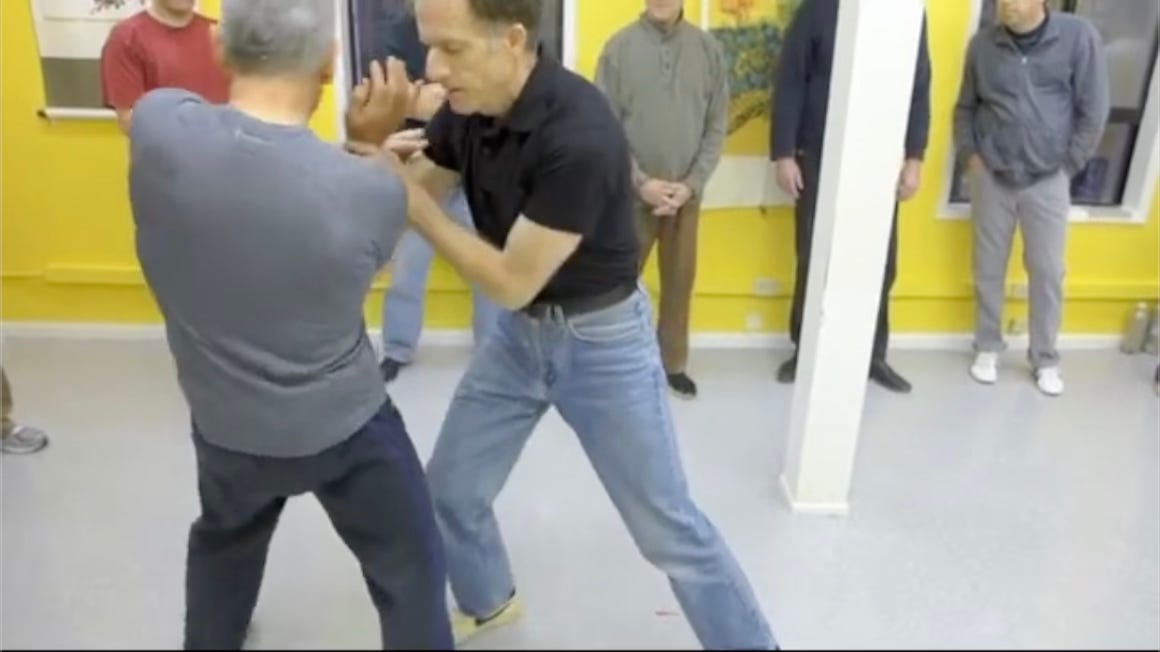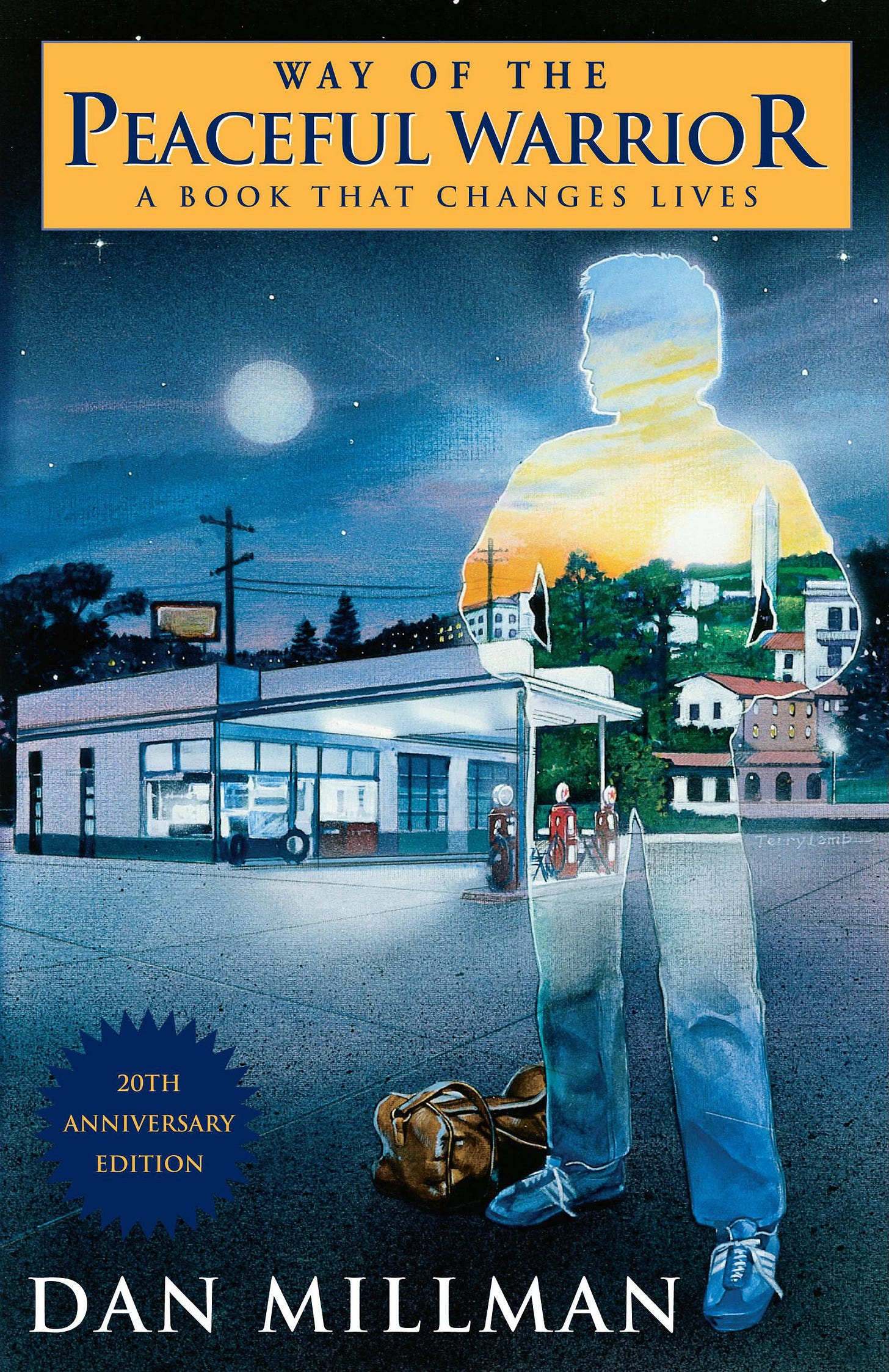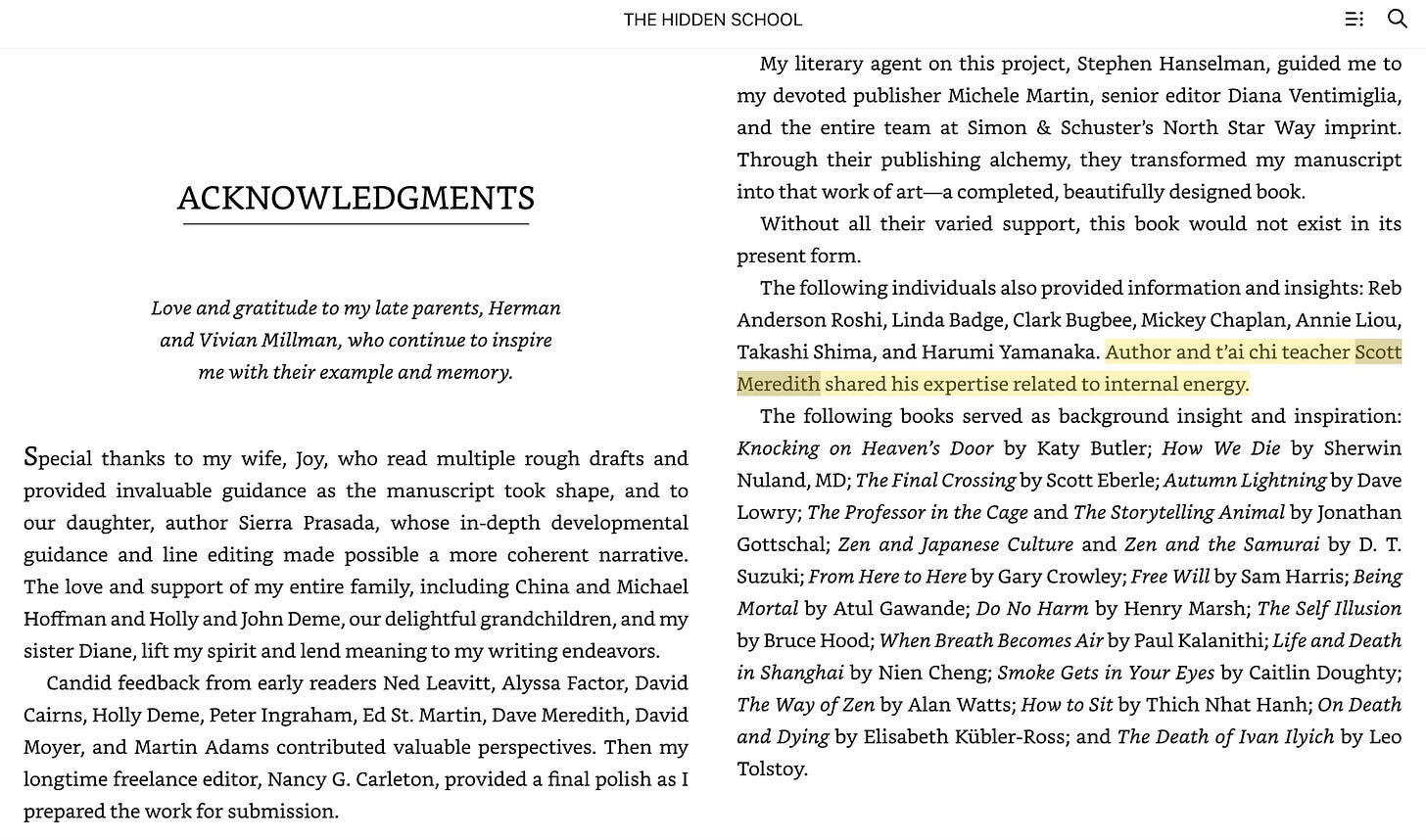I got a note from a reader of this recent PUSH mini-series, on a technical point. He pointed out that practitioners of non-Tai Chi styles, and even some Tai Chi people, have as their single ride-or-die goal that you must never be permitted to touch their body, meaning they try to protectively keep their torso as a no-go zone, so they keep you working with arms alone. Yet the goal of kuzushi remains, as ever, taking their (overall) balance, not just pretty maneuvers with arms-to-arms. So it’s a question: how can you take their whole body balance when you only have the arms to work with? But I’ll show how it can be done.
Arms-to-arms mode can be inconvenient from the pov of ‘pure’ Tai Chi push hands, but it’s a very reasonable overall guideline, especially for those who imagine that their push hands, Chi Sao, roushou, or other such regulated sensitivity drills will one day help them make the jump from the dojo into the ring, cage, bar, or street - which presumably represent real combatives! Given that your torso holds most of your vital components, and that many teachers have emphasized the “every hand is a knife” (reality orientation), it’s probably best that, in real life as opposed to training, you only permit that contact from those affectionately disposed toward you. And then, since we’re constantly reminded that you fight like you train, it further makes sense for many people to try to minimize torso contact even in the regulated training drills too. So that’s why tons of people will attempt to keep you at arm’s length. Some schools that emphasize roushou (flexible arms 柔手)) training drills practically make a fetish out of this no touch torso principle.
I myself don’t mind if partners want to try pushing on my torso. I actually encourage them to work from there in the beginning, so they can learn on the easier body part. I often let them shove as physically hard as they want on my chest, abs, shoulders, etc. Some people have criticized me for that, saying how dangerous it is to sacrifice realism in this way. What if he really had a knife? They have a point (no pun intended) but the entire configuration of push hands and te-age (see below) is already unrealistic from the git-go anyway. I mean, I’m not guarding against my partner head butting or pulling a gun or stomping on my foot. Although push hands in my training is non-compliant, infused with only that small touch of realism (keep your balance and try your best to unbalance the partner), still it’s just a drill based on conventional boundaries and standards.
Given that a lot of mainstream Tai Chi schools do however assume that the main leverage surface for pushing is the body (torso, not arms) working with such partners may seem problematic. And it is hard to move people’s body with only arm contact. Pulling is easier, but most even experienced Tai Chi people have trouble pushing from arm contact. The reason is easy to understand: most people can relax and move their arms at least enough to deprive you of any “resistance line” to trigger your push from.
Make no mistake - all push results, no matter how subtle they may appear, from any master or teacher, always depend on him finding a ‘resistance line’ inside you. A thin line of residual tension. Every Tai Chi push master is triggering off of that. That resistance line may be extremely subtle, hidden, well concealed etc. But if he gets you, that’s what he’s triggering off of. And I am using that too. The more advanced instructors can pro-actively create such a resistance line by using non-physical yinjection (see my book JUICE Taiji Energetics).
It’s definitely easier to work from a torso “resistance line” because on basically everybody the torso is physically less mobile and less maneuverable to get out of the incoming challenge, and also, most importantly, almost everybody’s torso is the storehouse of lots of unconscious tension. That unconscious tension is much harder to drop than the more conscious tension of people’s arms.
So for all these conscious and unconscious reasons, some people will do anything to keep your hands off their torso even in drills. Depending on your level, that can make it harder to ‘kuzushi’ (take balance of) such partners. But if you yourself are relaxed and you know how to do yinjection, it’s not an issue. You can move their whole body balance working from their arms alone. You just need to know how to mentally switch on ‘Tai Chi mode’.
The real-life martial arts supermaster Yukiyoshi Sagawa emphasized exactly this ‘arm work’ in his main flagship drill, called 手上 (te ah ge) or (arm raising). Although his orientation looks different (in that it emphasizes the defensive aspect of escaping from a grip by taking your partner’s balance, rather than proactively moving him by working from his arms alone), still it requires the exact same ‘Tai Chi mode’ of operation. Sagawa called that mode “Aiki” (cf. Transparent Power by Tatsuo Kimura).
Although I have frequently done kuzushi with this type of person (torso guarder), I don’t have a huge amount of videos showing it. I only move their body directly from their arms when they won’t “let” me touch their torso due to guarding, as explained. But I can certainly do it when it’s called for. I’ll sample a couple of clips down below just to give a rough idea of that style of work.
The first clip is interesting not only for the work but for the partner. My partner is well known martial arts adept, Dan Millman. He wrote one of the best-selling martial arts books ever: “The Way of the Peaceful Warrior”. It’s a mostly real life autobigraphy of his training background not only in martial arts but also as an Olympic level gymnast. Dan’s actually a superb athlete, and also just very well conditioned and physically super strong. He was along on two of our Russian Spetsnaz training trips, and has led workshops on meditation, spirituality, martial arts and related topics for years.
When he had occasion to write about Tai Chi specifically (in a later book) he came to me for some training and familiarity, which he kindly credited as below.
The short clip below shows me working with:
Dan Millman, at one of my seminars in San Francisco’s Chinatown back in the day. Basically we’re doing introductory arms-length work. Can his balance be taken in arm-centric mode?
Me doing a small bit of arm’s work with a very experienced Bay Area Tai Chi teacher, with some of my commentary.
Me doing bits and pieces of this arms-length work with yet another of those who guard their torso well. This partner is a very experienced martial artist and teacher, with a high rank in Aikido, and lots of depth in other arts as well. Can his balance be taken?
One more thing before we get to the clip. For simplicity, I sometimes break down Tai Chi modes by Element as: Earth, Fire, Water (micro), Water (macro), and Air. For arm-oriented work, Earth mode is most applicable. When working with straight arm grips, I usually just root their incoming push and just let it rebound back on them through theirautobiography arms. This is difficult if they don’t give you anything, but usually they unconsciously do, or they try to push me through my own arm contract on them. Neither will work if you just root and reflect with a small nudge, just that simple. So you’ll see relatively little movement in these arm situations. You could also yield completely (one of the Water modes) and come back immediately with your counter. But the yielding itself usually breaks the mutual arm grip configuration, so if you do that you generally end up getting on their torso, which wouldn’t be relevant for this post. I’ll show that in some other future post.
I apologize for my banter while working with them, mostly inane but I do try to reinforce a few teaching points so I’ve left the audio in place. If nothing else that’s more natural than removing the audio.
Keep reading with a 7-day free trial
Subscribe to "Make it So" - Now to keep reading this post and get 7 days of free access to the full post archives.




